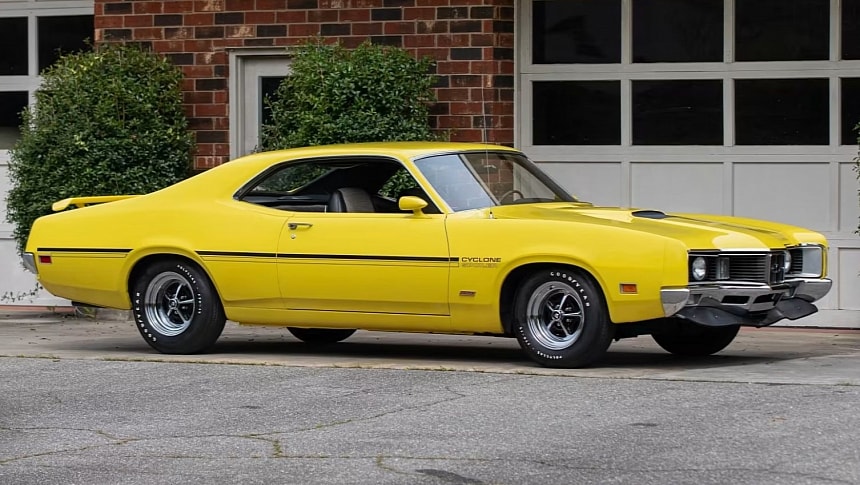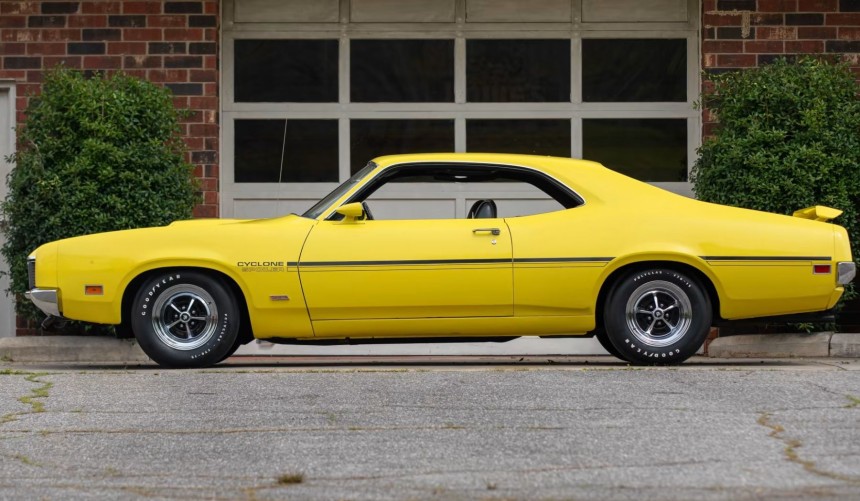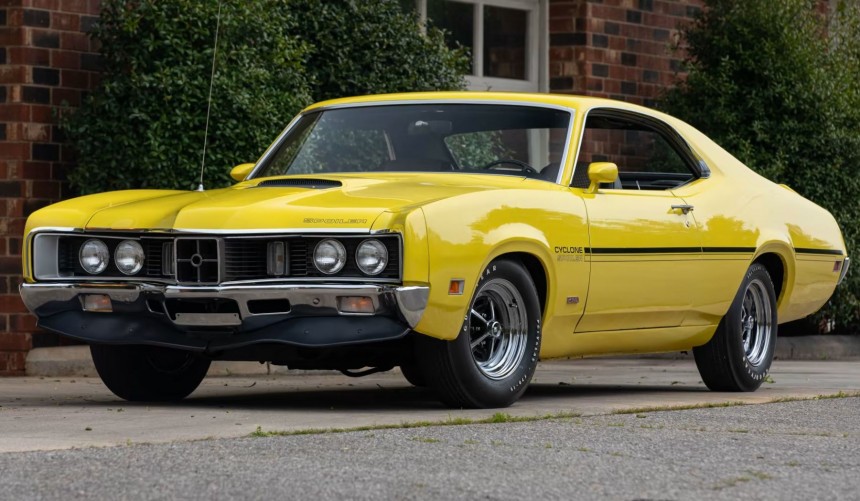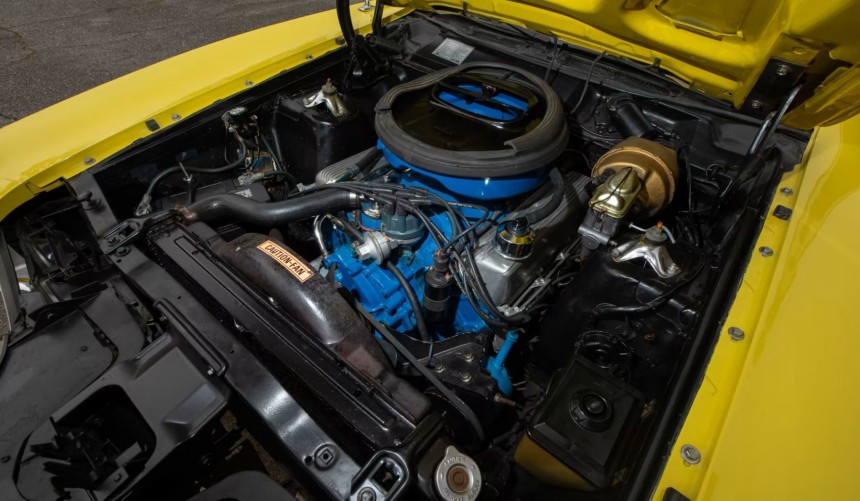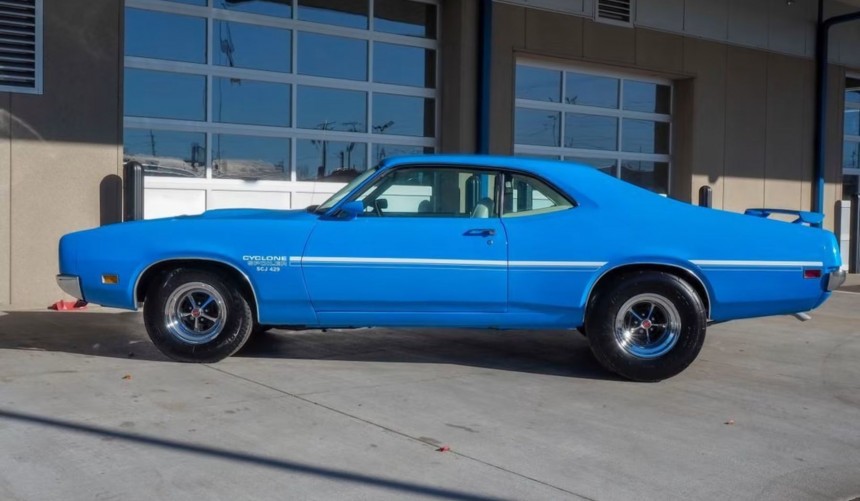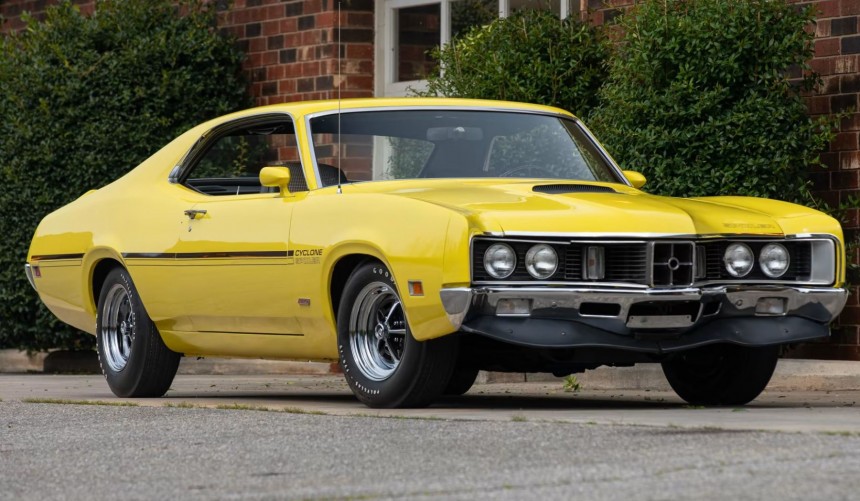Though it didn't prioritize developing flashy, high-performance rides during the golden age of muscle, Mercury did release several exciting rides that catered to the muscle car crowd, and one of the most memorable was the 1970 Cyclone Spoiler 429 Super Cobra Jet.
The short-lived yet unforgettable muscle car golden age, which gained serious momentum in 1964 when Pontiac introduced the GTO, peaked in 1970.
That year, GM lifted its self-imposed ban on fitting V8s larger than 400 cubic inches (6.5 liters) in anything but its full-size cars and Corvette halo sports car.
That opened the door to outrageous big-block V8s like the refreshed Chevelle (and El Camino) SS-bound 454-ci (7.4-liter) LS5 and the HEMI-slaying LS6.
The corporate decision also allowed Pontiac, Olds, and Buick to each add their own version of a 455-ci (7.5-liter) big-block to their respective high-performance intermediates, the GTO, 4-4-2, Gran Sport, or GSX.
In the Mopar camp, the 426 HEMI was still the most desirable high-performance engine and, apart from the upgraded Dodge and Plymouth intermediates, it was now available in the all-new E-body Barracuda and Challenger pony cars, making for an unrivaled power-to-weight ratio.
Even the small American Motors Corporation (AMC) was making an effort to remain relevant in the muscle car market with The Machine, a worthy Rebel-based successor to the awesome S/C Rambler co-developed with Hurst in 1969.
Of course, Ford also pushed the envelope when it came to its muscle cars with an all-new Torino Cobra and the slightly facelifted Boss 302 and Boss 429 Mustangs.
Introduced in 1938 to bridge the gap between the blue-collar Fords and luxurious Lincolns, Mercury went through a series of identity crises during its history and ultimately met its demise in 2011 because of the most serious one.
During the early 1960s, the brand continued to offer more upscale versions of Ford's main production models but was starting to enter one of the aforementioned identity crises.
Fortunately, a cure came in the second part of the decade when management decided to enter the muscle car segment with high-performance versions of the Cougar pony car and the compact (then intermediate) Comet.
Initially a high-performance trim of the Comet, the Cyclone became a separate model in 1968. For the epic 1970 model year, apart from the flashy Cougar Eliminator introduced a year earlier, Mercury launched a redesigned Cyclone.
Of the three 1970 Cyclones available - base, GT, and Spoiler - the latter was the version aimed at muscle car buffs in terms of both styling and performance.
During the previous model year, the Cyclone Spoiler was a mid-range performance model eclipsed by the top-performing Cyclone Cobra Jet, while the limited-edition Spoiler II was more or less a rebadged version of the Ford Torino Talladega meant to homologate the aerodynamic front-end upgrades for NASCAR.
However, for 1970, the Spoiler became the flagship muscle car and, although it shared the same semi-fastback roofline with the Torino Cobra, its bespoke front and rear ends gave the model its own identity.
With the new body based on the Montego, even the base Cyclone had a stylish yet fierce look about it, but the aggressiveness was taken to another level on the Spoiler by the addition of features such as a front chin spoiler, blacked-out grille, scooped hood, rear spoiler, and a list of new, eye-popping colors contrasted by a sleek side-stripe decal package.
Inside, the Spoiler came with features such as high-back vinyl bucket seats, a 140-mph (225 kph) speedometer, an 8,000-rpm tach, and a series of dash-mounted gauges oriented towards the driver.
Moreover, Mercury's flagship muscle car had a three-spoke Rim-Blow steering wheel and a simulated woodgrain center console that completed the upscale cabin.
In all, the 1970 Cyclone Spoiler was by no means less aggressive-looking than the most sought-after high-performance intermediates available that year. In fact, one can argue that appearance-wise, it was the most aggressive-looking muscle car of the year.
Unlike the base Cyclone and the GT, the Spoiler's standard V8 was the Ram-Air 429-ci (7.0-liter) Cobra Jet, FoMoCo's most powerful high-performance engine available on the intermediate line.
Conservatively rated at 370 hp and 450 lb-ft (612 Nm) of torque to keep insurance premiums at bay, the powerhouse was allegedly capable of producing a lot closer to 400 hp.
If that wasn't enough, customers could get the optional Super Cobra Jet 429, which was equipped with four-bolt mains, a more aggressive cam with solid lifters, forged aluminum pistons, adjustable rocker arms, and a 780-cfm Holley carb.
On paper, this upgraded engine was just five ponies more potent than the standard CJ, but again, the output figure was purposefully underrated. Moreover, with its four-bolt mains and solid lifters, the SCJ offered a great tuning platform and could produce serious power with just some bolt-on aftermarket upgrades.
With the SCJ option, the Spoiler also had to be equipped with one of two rear-end packages, the Drag Pak or Super Drag Pak. The first added a Traction-Lok rear with 3.91:1 gears and an external engine oil cooler, while the second brought the bombproof Detroit Locker with 4.30:1 gears.
Regardless of the engine chosen, the Spoiler's powertrain was completed by a standard close-ratio, Toploader four-speed manual featuring a Hurst T-handle shifter or an optional console-mounted C-6 Select-Shift automatic.
Additional mechanical upgrades received by the Cyclone Spoiler were a beefed-up suspension system (the Competition Handling Package), while stopping power was the model's only true weakness since it came with standard drums all around. However, front power-assisted disc brakes were available as a separate option.
When equipped with the 429 Super Cobra Jet and Super Drag Pak combo, the Cyclone Spoiler could sprint to 60 mph (97 kph) from a standstill in 5.5 seconds. As for the standing quarter mile, the car could easily achieve runs in the low 14-second range, albeit some owners reported going into the high 13s with full stock examples.
While it wasn't the quickest high-performance intermediate of 1970, the Spoiler certainly could hold its own against many rivalring models.
Despite its aggressive looks and potent optional engine, the Cyclone Spoiler 429 SCJ was not as appealing as the most powerful versions of the Pontiac GTO, Chevy Chevelle SS, or Plymouth Road Runner, so Mercury only managed to sell 341 examples out of the total of 1,631 Spoilers.
Save for the side stripes, the Spoiler returned for 1971 in an identical guise, but due to the sluggish sales from the previous model year, the SCJ option was discontinued.
Few of these incredible muscle cars are still around, and even fewer are highly original, low-mileage examples.
Grossly underrated in 1970 and still so today, the Cyclone Spoiler 429 SCJ can be had for far less than equally rare muscle car icons produced that year.
The yellow example shown above, which was equipped with the 429 SCJ and the Drag Pak from the factory, fetched $60,500 at the Mecum Indy auction in 2022.
To put it into perspective, a 1970 Chevy Chevelle SS 454 LS6 in a similar condition fetched $165,000 several months earlier at another auction organized by Mecum.
An iconic yet underrated muscle car from the era's most exciting model year, the Mercury Cyclone Spoiler 429 Super Cobra Jet deserves to be remembered and celebrated.
You can take a virtual tour of this rare and awesome ride in the video below, posted on YouTube by American Muscle Car Museum.
That year, GM lifted its self-imposed ban on fitting V8s larger than 400 cubic inches (6.5 liters) in anything but its full-size cars and Corvette halo sports car.
That opened the door to outrageous big-block V8s like the refreshed Chevelle (and El Camino) SS-bound 454-ci (7.4-liter) LS5 and the HEMI-slaying LS6.
The corporate decision also allowed Pontiac, Olds, and Buick to each add their own version of a 455-ci (7.5-liter) big-block to their respective high-performance intermediates, the GTO, 4-4-2, Gran Sport, or GSX.
In the Mopar camp, the 426 HEMI was still the most desirable high-performance engine and, apart from the upgraded Dodge and Plymouth intermediates, it was now available in the all-new E-body Barracuda and Challenger pony cars, making for an unrivaled power-to-weight ratio.
Even the small American Motors Corporation (AMC) was making an effort to remain relevant in the muscle car market with The Machine, a worthy Rebel-based successor to the awesome S/C Rambler co-developed with Hurst in 1969.
Of course, Ford also pushed the envelope when it came to its muscle cars with an all-new Torino Cobra and the slightly facelifted Boss 302 and Boss 429 Mustangs.
Mercury's contribution to the most exciting model year of the era
During the early 1960s, the brand continued to offer more upscale versions of Ford's main production models but was starting to enter one of the aforementioned identity crises.
Fortunately, a cure came in the second part of the decade when management decided to enter the muscle car segment with high-performance versions of the Cougar pony car and the compact (then intermediate) Comet.
Initially a high-performance trim of the Comet, the Cyclone became a separate model in 1968. For the epic 1970 model year, apart from the flashy Cougar Eliminator introduced a year earlier, Mercury launched a redesigned Cyclone.
Of the three 1970 Cyclones available - base, GT, and Spoiler - the latter was the version aimed at muscle car buffs in terms of both styling and performance.
One of the most aggressive-looking muscle cars of the Golden Age
However, for 1970, the Spoiler became the flagship muscle car and, although it shared the same semi-fastback roofline with the Torino Cobra, its bespoke front and rear ends gave the model its own identity.
With the new body based on the Montego, even the base Cyclone had a stylish yet fierce look about it, but the aggressiveness was taken to another level on the Spoiler by the addition of features such as a front chin spoiler, blacked-out grille, scooped hood, rear spoiler, and a list of new, eye-popping colors contrasted by a sleek side-stripe decal package.
Inside, the Spoiler came with features such as high-back vinyl bucket seats, a 140-mph (225 kph) speedometer, an 8,000-rpm tach, and a series of dash-mounted gauges oriented towards the driver.
Moreover, Mercury's flagship muscle car had a three-spoke Rim-Blow steering wheel and a simulated woodgrain center console that completed the upscale cabin.
In all, the 1970 Cyclone Spoiler was by no means less aggressive-looking than the most sought-after high-performance intermediates available that year. In fact, one can argue that appearance-wise, it was the most aggressive-looking muscle car of the year.
A Merc with underrated superpowers
Conservatively rated at 370 hp and 450 lb-ft (612 Nm) of torque to keep insurance premiums at bay, the powerhouse was allegedly capable of producing a lot closer to 400 hp.
If that wasn't enough, customers could get the optional Super Cobra Jet 429, which was equipped with four-bolt mains, a more aggressive cam with solid lifters, forged aluminum pistons, adjustable rocker arms, and a 780-cfm Holley carb.
On paper, this upgraded engine was just five ponies more potent than the standard CJ, but again, the output figure was purposefully underrated. Moreover, with its four-bolt mains and solid lifters, the SCJ offered a great tuning platform and could produce serious power with just some bolt-on aftermarket upgrades.
With the SCJ option, the Spoiler also had to be equipped with one of two rear-end packages, the Drag Pak or Super Drag Pak. The first added a Traction-Lok rear with 3.91:1 gears and an external engine oil cooler, while the second brought the bombproof Detroit Locker with 4.30:1 gears.
Regardless of the engine chosen, the Spoiler's powertrain was completed by a standard close-ratio, Toploader four-speed manual featuring a Hurst T-handle shifter or an optional console-mounted C-6 Select-Shift automatic.
While it wasn't the top performer of 1970, the SCJ Spoiler could hold its own
When equipped with the 429 Super Cobra Jet and Super Drag Pak combo, the Cyclone Spoiler could sprint to 60 mph (97 kph) from a standstill in 5.5 seconds. As for the standing quarter mile, the car could easily achieve runs in the low 14-second range, albeit some owners reported going into the high 13s with full stock examples.
While it wasn't the quickest high-performance intermediate of 1970, the Spoiler certainly could hold its own against many rivalring models.
Extremely rare but currently not as expensive as you might think
Save for the side stripes, the Spoiler returned for 1971 in an identical guise, but due to the sluggish sales from the previous model year, the SCJ option was discontinued.
Few of these incredible muscle cars are still around, and even fewer are highly original, low-mileage examples.
Grossly underrated in 1970 and still so today, the Cyclone Spoiler 429 SCJ can be had for far less than equally rare muscle car icons produced that year.
The yellow example shown above, which was equipped with the 429 SCJ and the Drag Pak from the factory, fetched $60,500 at the Mecum Indy auction in 2022.
To put it into perspective, a 1970 Chevy Chevelle SS 454 LS6 in a similar condition fetched $165,000 several months earlier at another auction organized by Mecum.
An iconic yet underrated muscle car from the era's most exciting model year, the Mercury Cyclone Spoiler 429 Super Cobra Jet deserves to be remembered and celebrated.
You can take a virtual tour of this rare and awesome ride in the video below, posted on YouTube by American Muscle Car Museum.
